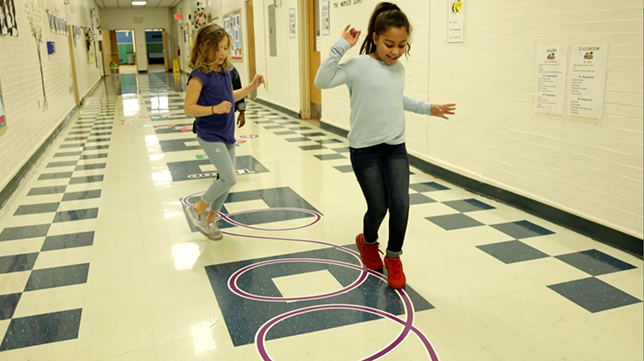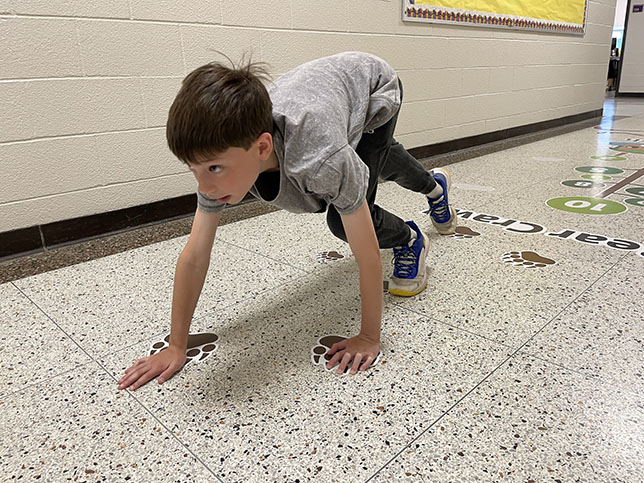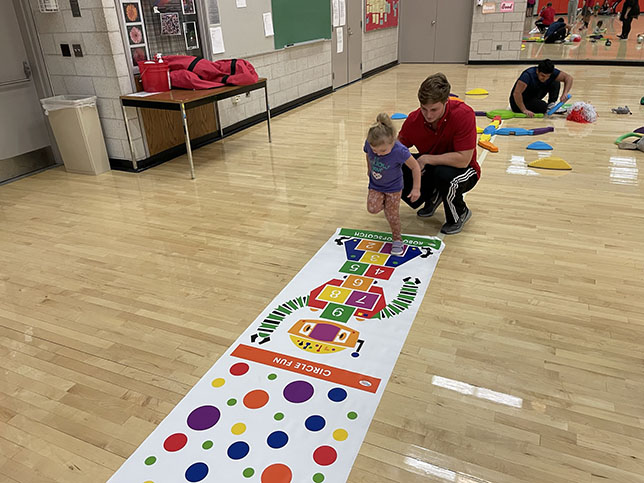Unveiling the Research-Based Benefits of Sensory Movement Pathways for Children
By Dr. Tim Davis & Matt Schinelli
Incorporating sensory movement pathways in schools can offer several benefits for students' physical, cognitive, and emotional development. These pathways are designed to engage multiple senses and provide students with a structured way to engage in physical movement throughout the day. Sensory movement pathways, also known as sensory pathways or sensory trails, have gained attention for their potential benefits in promoting children's physical, cognitive, and emotional development.
Sensory movement pathways encourage regular physical activity, helping students stay active and combat sedentary behaviors. Regular movement can contribute to improved cardiovascular health, better muscle tone, and enhanced overall physical fitness.
Take a closer look at these eye-opening insights regarding the benefits of sensory movement pathways for children.

Images courtesy of Fit and Fun Playscapes
Cognitive Engagement
Physical movement has been shown to stimulate brain activity and enhance cognitive functions such as attention, memory, and problem-solving skills. Sensory movement pathways provide a way for students to take short breaks from classroom activities, potentially boosting their ability to focus and retain information.
Many children who are motorically unique due to developmental/neurological issues often miss out on vital cognitive/social skills acquired from play/practice with fellow peers. As a result, those students get pushed further and further away from traditional movement experiences.
Cognitive “isolation” is a real obstacle and often can be reduced with the use of sensory pathways, which allows authentic expressions of expression in movement. When all students have the opportunity to engage in inclusive teaching tools like sensory pathways, there is a greater opportunity for nature play.
Sensory Integration
Sensory movement pathways engage multiple senses, including touch, balance, and proprioception. These sensory inputs contribute to sensory integration, which is crucial for children’s overall sensory development and can positively impact their ability to process information from their environment. In terms of sensory integration as it relates to the long-term goal of sharing community-based peer inclusive movement experiences (i.e., bike riding, bowling, basketball, hiking, etc.), sensory pathways allow individuals with unique needs to establish outlets, which instructional specialists can build upon. For example, when an individual demonstrates excitement and interest in a particular part of a pathway, the teacher/therapist can build upon that excitement by increasing the capacity of the movement, or can adapt that movement so that it can transfer to more traditional activity experiences.

Stress Reduction & Behavioral Regulation
Physical activity, especially activities that involve rhythmic or repetitive movements, can help reduce stress and anxiety. Sensory movement pathways offer students a way to release pent-up energy and manage emotional stress, promoting a more conducive learning environment.
The use of sensory pathways helps individuals to discover and establish “degrees of independence.” When students are physically comfortable/relaxed they increase their capacity to develop physical independence, as opposed to when a student is upset or overly tense then he/she is less likely to increase his/her independence capacity. This principle rings true when also managing behavioral regulation issues. Simply put, when students feel connected and values an experience, then he/she will engage the activity for longer, with more jest and willingness to work with others.
Behavioral Regulation
Engaging in physical movement through sensory pathways can help students to regulate their behavior and emotions. Movement breaks can provide an outlet for excess energy and frustration, reducing the likelihood of disruptive behavior in the classroom.
Improved Mood
Physical activity is known to trigger the release of endorphins, which are natural mood boosters. Incorporating sensory movement pathways into the school day can contribute to a more positive and uplifting atmosphere, enhancing students’ overall well-being.
Variety & Engagement
Traditional classroom settings can sometimes become monotonous, leading to boredom and disengagement. Sensory movement pathways introduce variety into the learning environment, making school more enjoyable and interactive for students.
Inclusive Learning
Sensory movement pathways can be tailored to accommodate various sensory preferences and needs, making them an inclusive tool for students with different learning styles, abilities, and sensory sensitivities.
Brain Development
Physical movement, particularly activities that involve cross-lateral movements (movements that engage both sides of the body), can support brain development by fostering connections between different brain regions.
Skill Development
Sensory movement pathways often include activities that challenge balance, coordination, and motor skills. Regular engagement with these pathways can lead to improved motor skills and body awareness. Again, children who are motorically unique due to developmental/neurological issues often miss out on vital cognitive/social skills acquired from play/practice with fellow peers.
As a result, those students get pushed further and further away from traditional movement experiences. Traditional school and community-based recreation activities all begin from “foundation skills” such as general coordination, core strength, balance, body awareness, etc.
Sensory pathways are incredibly effective tools in helping teachers/therapists develop the necessary “foundation skills.” Without the use of structured well-thought out designed sensory pathways, teachers/therapists would have to spend huge amounts of time constantly trying to figure out ways to adapt traditional instructional tools. In the public school setting, that “time” simply does not exist, and many teachers never received the formal training needed to successfully adapt instructional tools.

Social Interaction
Sensory movement pathways can be designed for group activities, encouraging social interaction and cooperation among students. This can help build positive peer relationships and teamwork skills.
Takeaways
It’s important to note that the design and implementation of sensory movement pathways should consider the age, developmental stage, and specific needs of the students. Collaborating with educators, physical therapists, and occupational therapists can help create effective and safe pathways that maximize the benefits for students. By incorporating sensory pathways into an elementary school environment, educators can create a dynamic and engaging space that support children’s sensory, motor, and social development. These pathways not only provide opportunities for exploration and learning, but also cater to diverse learning styles and abilities, fostering a more inclusive and enriching educational experience.
Sensory pathways and movement activities are not only beneficial for typical development, but also hold immense promise for children with varying abilities and needs. The referenced research underscores the positive impact of these activities on cognitive, sensory, motor, emotional, and social aspects of development. By embracing and incorporating sensory-rich experiences and movement interventions, caregivers, educators, and parents can create environments that cater to the diverse developmental needs of all children.
Timothy D. Davis, Ph.D., is a professor in the Physical Education Department at State University of New York at Cortland. He is the Chair of the Adapted Physical Education National Standards and Certification Exam and the Director of the Sensory Integration Motor Sensory/Multi-Sensory (SIMS/MSE) Lab.
Matthew Schinelli M.ED has served as a leading expert in the field of Inclusive Movement Services. Presently he serves as an inclusive Physical Education Teacher at Blue Ribbon awarded E.W. Chittum Elementary School for the Chesapeake Public Schools District. Additional background information includes having founded several companies that were awarded on the local, state, national and international level for their direct services in the area of inclusive movement. Matt has a unique expertise in helping both public and private entities enhance their movement offerings so that they can achieve more authentic Inclusive Movement experiences.